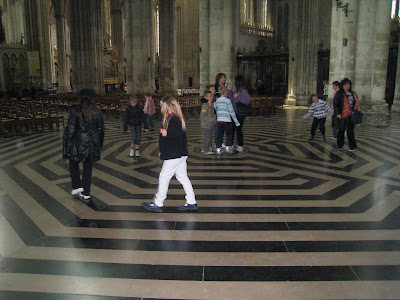June 1- 2, 2010
Amiens Cathedral is generally considered to be the greatest example of High Gothic style as Amiens is the tallest Gothic church and largest cathedral in France. Just as Chartres cathedral was being finished, Amiens was being started.
Amiens became one of the most important pilgrimage destinations in Europe when the head of St. John the Baptist was brought back from Constantinople by Crusaders.
The Amiens labyrinth was installed in 1288 by the architect Renaud de Cormont (who signed his work) and bears an inscription naming the architects of the cathedral. Unfortunately, unlike the medieval labyrinth at Chartres, this one did not survive the Revolution intact; the present version is an exact copy made in the 19th century. Its path stretches 240 meters in length. The path turns are the same as the Chartres design, but they are organized in an octagon, and the path and lines are the same width. The path is the darker line. The central stone of the labyrinth has portraits in inlaid marble of the bishop who built the cathedral and the first three architects, with an inscription in copper naming the four figures and the year the foundation stone was laid (1220). You can see the original center stone in the Musée de Picardie.
Chartres, Amiens and Saint-Quentin cathedral labyrinths were all laid out in the same pattern. They were formed by 11 concentric circles that contained a single path which slowly leads to a center rosette. The path makes 28 loops, seven on the left side toward the center, then seven on the right side toward the center, followed by seven on the left side toward the outside, and finally seven on the right side toward the outside, ending in a short straight path to the rosette.

A school group of children also enjoyed walking the labyrinth!







No comments:
Post a Comment